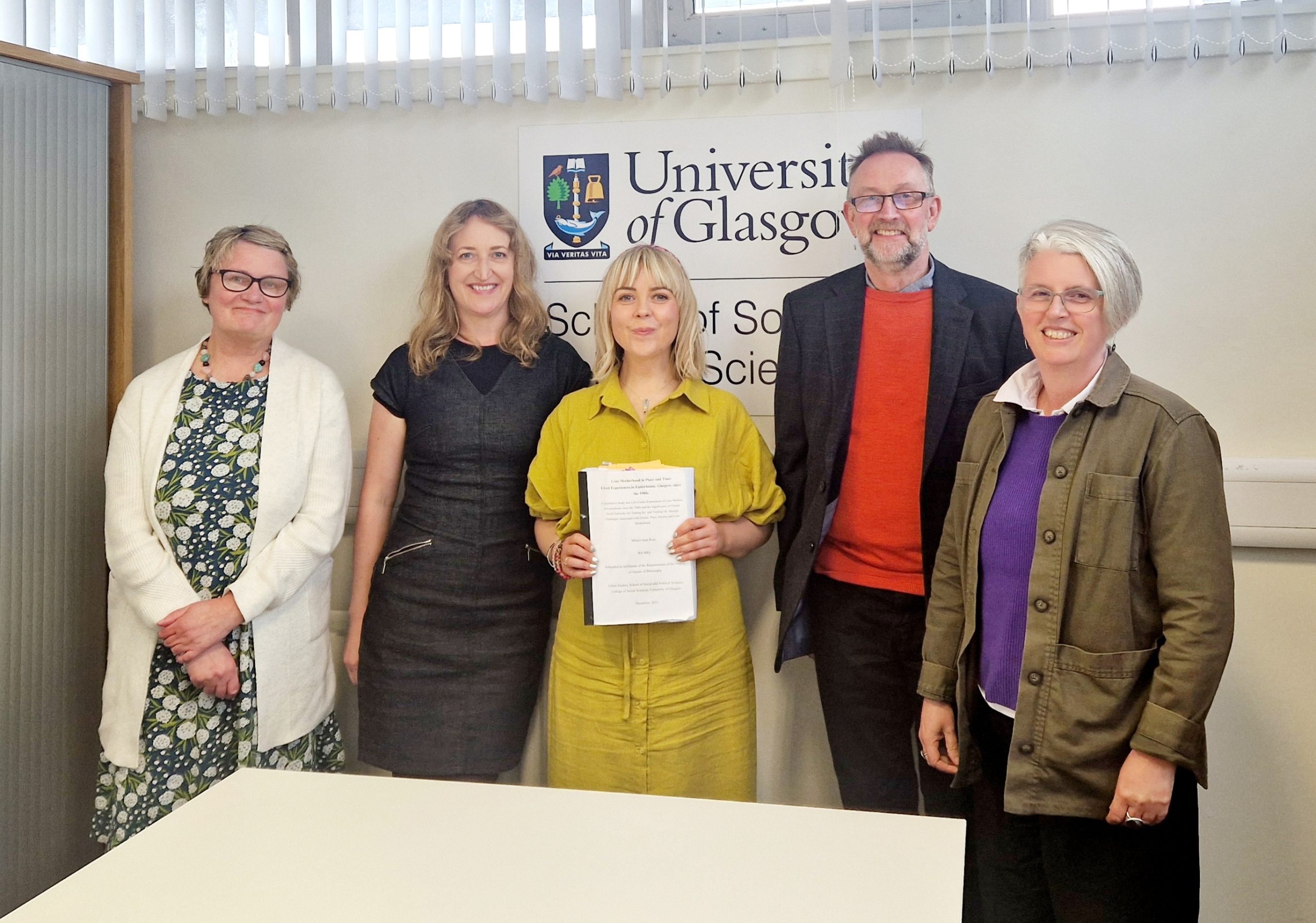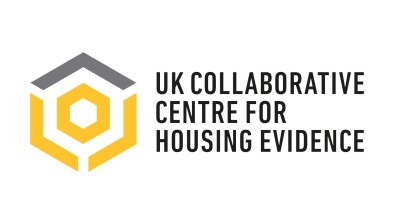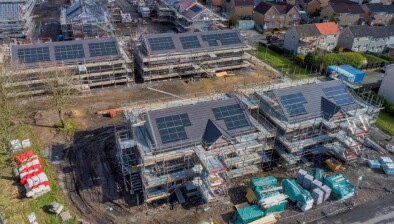Dr Mhairi Ross: Tales from Easterhouse - understanding the resilience of lone mothers across generations

Dr Mhairi Ross, a recent PhD graduate, discusses her thesis on lone mothers’ experiences in Easterhouse since the 1980s, emphasising the significance of female social networks and the impact of gender-based inequalities and structural violence.
As one of the first CaCHE PhD students, could you provide some background on your experience?
In 2017, I applied for a CaCHE PhD Scholarship titled, ‘Why does deprivation endure – Biographies of people and places’ funded by Glasgow University College of Social Sciences. When developing my research proposal, I was a first-time new mum to a six-month-old baby living in Shettleston. The scholarship title caught my attention as I’d grown up in several of Scotland’s most deprived housing estates, including Glasgow, Edinburgh, and the Highlands. I’ve spent over fifteen years working in community development projects in deprived neighbourhoods in Glasgow in various settings, including homelessness services, mental health services, suicide prevention and, latterly, as a community connector practitioner based within housing associations in the East End of Glasgow. I suppose I felt that my lived experience and existing insight into biographies of people in deprived neighbourhoods would lend rigour and authenticity to the research. I also felt, and still feel, it is important that working-class people are those best placed to frame their own experiences of structural inequalities.
Around 2014, I embarked on a MEd qualification in Community Learning and Development. I was awarded a distinction and invited back to lecture on the Masters program. During my time with the CLD team at Glasgow, I was exposed to a raft of new literature relating to social justice, transformational pedagogy, and community organising, which formed the cornerstone of my methodological Working Class, Feminist, Emancipatory approach to the PhD research. So, taken together, I came to the PhD as a working-class new mum with a passion for change-making, looking for a new challenge and hoping for a chance to shine a light on important stories that I believed were often overlooked.
Your thesis looks at lone mothers’ experiences in Easterhouse since the 1980s and the significance of female social networks. Could you outline why this topic was important to you?
I’ve been listening this week to Darren McGarvey’s lecture to the RSE on trauma and the recounting of lived experience. Darren did a great job of articulating some of my worries about sharing some of my lived experience and cautioning against over disclosure for people with lived experience relating to issues such as generational poverty and gender-based inequalities. His reflections have been really useful in helping me to interrogate ‘how much is too much’ of myself to share regarding lived experience and research.
What is helpful for me to share is that I grew up as one of five in a low-income, lone mother-headed household during the 1980s and 1990s. My family spent over ten years living in Easterhouse during the 1970s and 80s. A neighbourhood that needs no explanation in this blog has continuously housed pockets of the highest levels of multiple deprivation in Europe since the 1970s, within a city known for its exceptional levels of health and socio-economic inequality.
The PhD research explored the life-course experiences of older women with experience of lone motherhood in Easterhouse 1980-2021 and the significance of female social networks for supporting women to navigate challenges associated with gender, place, poverty and lone motherhood. The 1980s were selected as an important historical juncture where lone mother-headed households in Easterhouse increased threefold and stayed well above the Glasgow average over a 41-year period. The 1980s were also a point in time where socio-economic inequalities and conditions of housing disrepair had reached a peak. Together, these factors raised important questions about how challenges relating to place during this period impacted women as they moved through the life course, the reasons for growing numbers of lone mothers in the peripheral estates, the mechanisms of support lone mothers used to overcome challenges and the impact of change over time for older women who have lived through Easterhouse’s waves of regeneration and reinvention.
These issues particularly interested me as a child of a lone mother-headed household during these decades. The research design was strongly influenced by my desire to step inside my own mother’s historical experiences and understand how time and place had shaped the trajectories of myself and my siblings. However, life began to imitate art when, in the second year of my studies and during the global pandemic, I, too, became a lone mother to a three-month-old baby and a two-year-old. The personal authenticity and engagement that I had hoped to add to the study suddenly took on a new dimension when I became not only the child of a lone mother-headed household but also a lone mother researching lone motherhood! I also moved away from Glasgow, my home of twenty years, to live in the north of England and situate myself amongst my own female family network.
What were some of the key findings from your research?
The major take -away messages of the PhD research highlighted that:
Gender was the overriding driver of disadvantage for lone mothers in the study. All women in the study had entered into lone motherhood as a result of domestic abuse, and that male perpetrated violence continued to be a life-long challenge for women in later life. Many experience intersecting effects of childhood sexual abuse, rape, domestic abuse and neighbourhood-based violence across the life course. Modern movements such as ~Metoo highlight the overarching impact of violence against women in the 21st century. However, my research found that in terms of time and place, exposure to various forms of control and violence, fanned by political and media rhetoric, formed the crucial backdrop to lone mother disadvantage. By the later decades of the 20th century, domestic abuse was recognised to be such a significant issue within Glasgow’s peripheral estates that Woman’s Aid began to situate services directly within estates such as Easterhouse and Castlemilk. The 1980s and 1990s were key decades where feminist interventions alongside rising UK-wide trends towards lone motherhood and legislation creating greater ease of homelessness housing allocation and access to in-work benefits created the conditions for many in the most abusive relationships to consider the possibility of leaving abusive situations.
In terms of place, most lone mothers in the study actively chose to stay in Easterhouse on account of belonging and access to support. The 1990s were again a critical time when regeneration and housing renewal resulted in greater neighbourhood and housing satisfaction often attributed to the tenant-led structures within Community Controlled Housing Associations. Half the group became homeowners by later life, often due to the uptake of ‘Right to Buy’ legislation and marginally improved economic positions relating to educational attainment and greater numbers of jobs in community-based and caring sectors. However, older women often reported struggles to reconcile their experiences of generational poverty and poor housing in Easterhouse with new facilities based on middle-class tastes and habitus such as Glasgow Fort, Arts opportunities and growing visibility of upper working class demographic signalling the need for further research into how older members of socially segregated spaces like Easterhouse adapt to regenerative change.
The research also made some interesting new findings around how women with experiences of stacked personal adversities and trauma relate to economic conceptions of ‘getting on’ in life and how structural inequalities impact conceptions of how older women like those of my participant group identify with lives well lived which you can read more about these insights in forthcoming journal articles.
Finally, in terms of the significance of female social networks of support over the life course for lone mothers, the research made some crucial discoveries around the composition and functions of female networks and strategic engagement with different forms of network support during stages of the life course to plug support gaps relating to inequalities. Most reflected ultimately that although female networks of solidarity formed the key conduits for ‘getting by’ active stages of childrearing and support with the needs of adult children, personal resources and values systems were the most valuable determinants of ‘getting by’ lives punctuated by trauma and personal tragedy related to structural violence.
What’s next?
In the weeks and months ahead, I’ll be involved in various events to share the findings of the PhD research in more depth. As I’ve already mentioned, I’m working on publications, which I’ll be talking more about soon.
I’ll also present the findings at the Working-Class Studies Association Conference on 6 June and share insights on Bow Focske’s podcast, ‘Motherhood Rawful but True’ during the first week in June.
Finally, subject to scheduling, I plan to host a a participatory event aimed at engaging participants in exploring the knowledge from the research and situating the research back within Easterhouse in order that those of younger generations and community organisations can explore the historical lived experience of mothers and grandmothers to understand the personal journeys which shape family and community life in Easterhouse and Glasgow. It is important for me to disseminate the knowledge in accessible and participatory formats, which hold the potential for dialogue and new learning in communities themselves. More details of these events in the east end to follow. Hope to see as many as possible of my CaCHE colleagues at these events.
This article was originally published on the CaCHE website.








